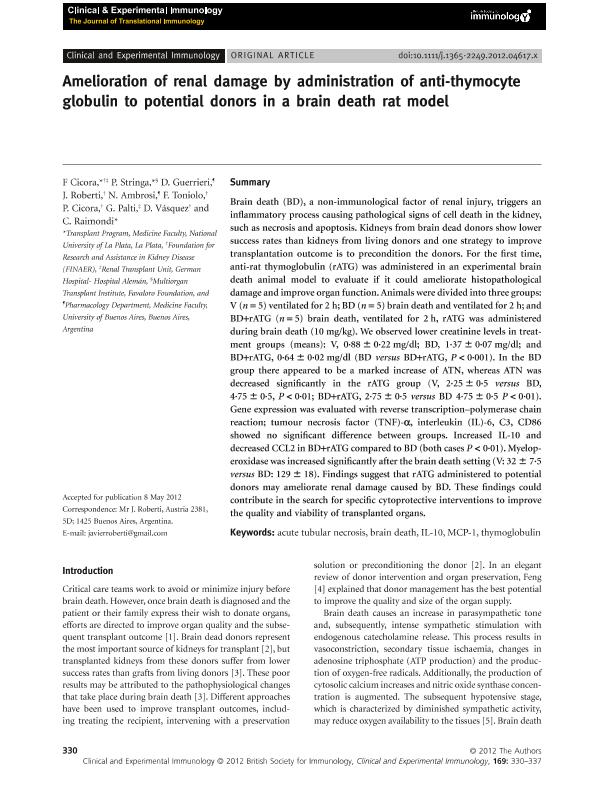Artículo
Amelioration of renal damage by administration of anti-thymocyte globulin to potential donors in a brain death rat model
Cicora, F.; Stringa, Pablo Luis ; Guerrieri, Diego
; Guerrieri, Diego ; Roberti, J.; Ambrosi, Nella Gabriela
; Roberti, J.; Ambrosi, Nella Gabriela ; Toniolo, F.; Cicora, P.; Palti, G.; Vasquez, D.; Raimondi, C.
; Toniolo, F.; Cicora, P.; Palti, G.; Vasquez, D.; Raimondi, C.
 ; Guerrieri, Diego
; Guerrieri, Diego ; Roberti, J.; Ambrosi, Nella Gabriela
; Roberti, J.; Ambrosi, Nella Gabriela ; Toniolo, F.; Cicora, P.; Palti, G.; Vasquez, D.; Raimondi, C.
; Toniolo, F.; Cicora, P.; Palti, G.; Vasquez, D.; Raimondi, C.
Fecha de publicación:
09/2012
Editorial:
Wiley Blackwell Publishing, Inc
Revista:
Clinical and Experimental Immunology
ISSN:
0009-9104
Idioma:
Inglés
Tipo de recurso:
Artículo publicado
Clasificación temática:
Resumen
Brain death (BD), a non-immunological factor of renal injury, triggers an inflammatory process causing pathological signs of cell death in the kidney, such as necrosis and apoptosis. Kidneys from brain dead donors show lower success rates than kidneys from living donors and one strategy to improve transplantation outcome is to precondition the donors. For the first time, anti-rat thymoglobulin (rATG) was administered in an experimental brain death animal model to evaluate if it could ameliorate histopathological damage and improve organ function. Animals were divided into three groups: V (n=5) ventilated for 2h; BD (n=5) brain death and ventilated for 2h; and BD+rATG (n=5) brain death, ventilated for 2h, rATG was administered during brain death (10mg/kg). We observed lower creatinine levels in treatment groups (means): V, 0·88±0·22mg/dl; BD, 1·37±0·07mg/dl; and BD+rATG, 0·64±0·02mg/dl (BD versus BD+rATG, P<0·001). In the BD group there appeared to be a marked increase of ATN, whereas ATN was decreased significantly in the rATG group (V, 2·25±0·5 versus BD, 4·75±0·5, P<0·01; BD+rATG, 2·75±0·5 versus BD 4·75±0·5 P<0·01). Gene expression was evaluated with reverse transcription-polymerase chain reaction; tumour necrosis factor (TNF)-α, interleukin (IL)-6, C3, CD86 showed no significant difference between groups. Increased IL-10 and decreased CCL2 in BD+rATG compared to BD (both cases P<0·01). Myeloperoxidase was increased significantly after the brain death setting (V: 32±7·5 versus BD: 129±18). Findings suggest that rATG administered to potential donors may ameliorate renal damage caused by BD. These findings could contribute in the search for specific cytoprotective interventions to improve the quality and viability of transplanted organs.
Palabras clave:
ACUTE TUBULAR NECROSIS
,
BRAIN DEATH
,
IL-10
,
MCP-1
,
THYMOGLOBULIN
Archivos asociados
Licencia
Identificadores
Colecciones
Articulos(CEFYBO)
Articulos de CENTRO DE ESTUDIOS FARMACOLOGICOS Y BOTANICOS
Articulos de CENTRO DE ESTUDIOS FARMACOLOGICOS Y BOTANICOS
Articulos(SEDE CENTRAL)
Articulos de SEDE CENTRAL
Articulos de SEDE CENTRAL
Citación
Cicora, F.; Stringa, Pablo Luis; Guerrieri, Diego; Roberti, J.; Ambrosi, Nella Gabriela; et al.; Amelioration of renal damage by administration of anti-thymocyte globulin to potential donors in a brain death rat model; Wiley Blackwell Publishing, Inc; Clinical and Experimental Immunology; 169; 3; 9-2012; 330-337
Compartir
Altmétricas



